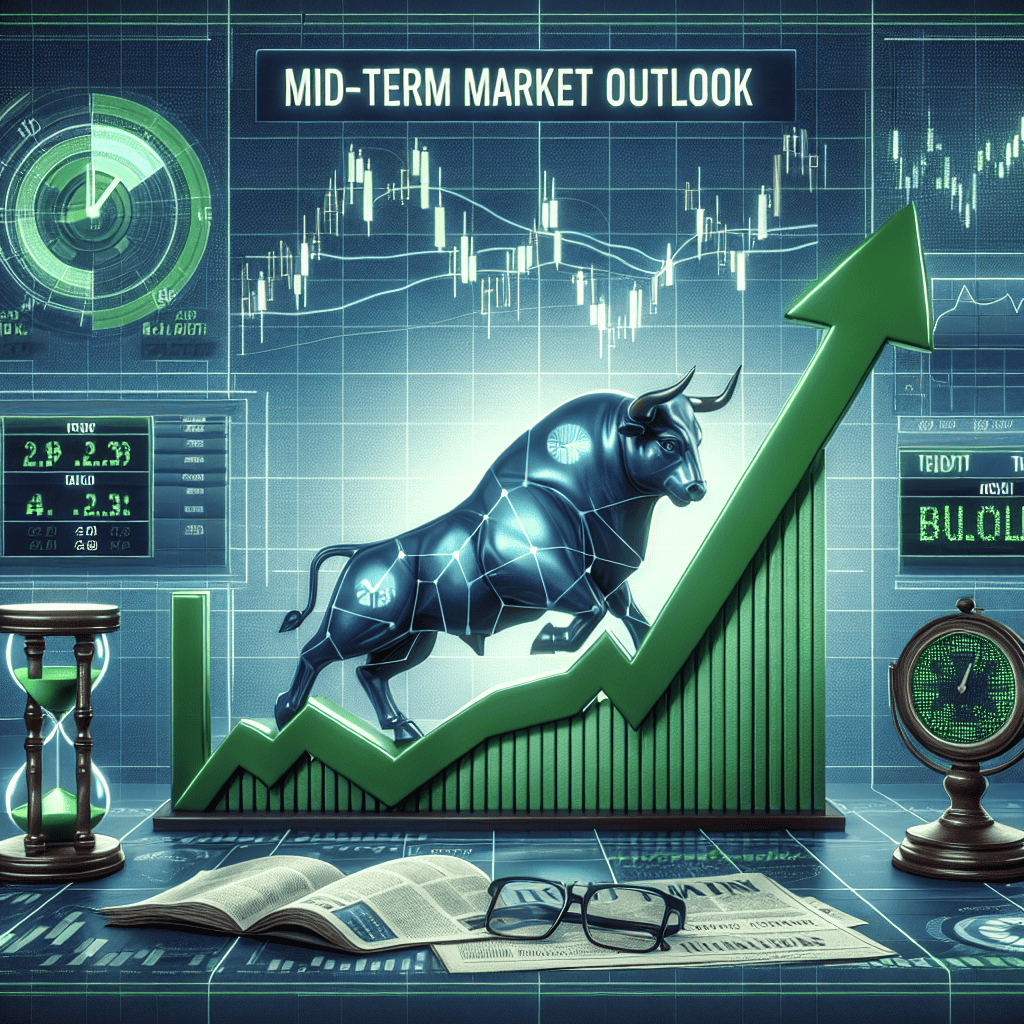“Mid-Term Market Outlook: Riding the Bullish Wave to New Opportunities”
Introduction
The mid-term market outlook presents a compelling narrative for investors, as recent analyses have identified a series of bullish signals that suggest potential upward momentum in the financial markets. These indicators, which encompass a range of economic, technical, and sentiment-driven factors, point towards a favorable environment for growth and investment. As global economies continue to navigate post-pandemic recovery, the alignment of these bullish signals offers a promising landscape for market participants. This outlook delves into the key drivers behind the anticipated market trends, providing insights into the sectors and strategies poised to benefit from the emerging bullish sentiment.
Analyzing Key Bullish Indicators in the Mid-Term Market Outlook
In the ever-evolving landscape of financial markets, investors and analysts continuously seek to identify patterns and signals that may indicate future trends. As we delve into the mid-term market outlook, recent analyses have detected several bullish signals that suggest a positive trajectory for the markets. Understanding these indicators is crucial for investors aiming to make informed decisions and capitalize on potential opportunities.
One of the primary bullish indicators currently observed is the robust performance of corporate earnings. Over the past few quarters, many companies have reported earnings that exceed market expectations, driven by strong consumer demand and operational efficiencies. This trend is particularly evident in sectors such as technology, healthcare, and consumer goods, where innovation and adaptability have played pivotal roles in sustaining growth. As companies continue to demonstrate resilience and profitability, investor confidence is bolstered, contributing to a more optimistic market sentiment.
In addition to corporate earnings, macroeconomic factors also play a significant role in shaping the mid-term market outlook. Recent data indicates a steady recovery in global economic activity, supported by accommodative monetary policies and fiscal stimulus measures implemented by governments worldwide. Central banks have maintained low interest rates to encourage borrowing and investment, while fiscal policies have focused on infrastructure development and job creation. These measures have collectively fostered an environment conducive to economic expansion, further reinforcing bullish market expectations.
Moreover, the labor market’s gradual improvement is another encouraging sign. Unemployment rates have been declining as businesses resume operations and hiring accelerates. This trend not only reflects economic recovery but also enhances consumer spending power, which is a critical driver of economic growth. As more individuals gain employment and disposable incomes rise, consumer confidence is likely to strengthen, leading to increased consumption and investment in various sectors.
Transitioning to the realm of market sentiment, investor behavior and sentiment indices provide valuable insights into the prevailing mood of the market. Recent surveys and sentiment indicators reveal a growing sense of optimism among investors, with many expressing confidence in the market’s ability to sustain its upward trajectory. This positive sentiment is often self-reinforcing, as it encourages further investment and risk-taking, thereby fueling market momentum.
Furthermore, technical analysis offers additional evidence of bullish signals. Key technical indicators, such as moving averages and relative strength indices, suggest that markets are in an upward trend. For instance, the sustained movement of stock prices above their long-term moving averages is typically interpreted as a bullish signal, indicating that the market is likely to continue its ascent. Similarly, relative strength indices that remain in overbought territory suggest strong buying interest, further supporting the bullish outlook.
While these indicators collectively paint a promising picture, it is essential to acknowledge potential risks and uncertainties that could impact the mid-term market outlook. Geopolitical tensions, unexpected shifts in monetary policy, and unforeseen economic disruptions remain factors that could alter the current trajectory. Therefore, investors should remain vigilant and consider a diversified approach to mitigate potential risks.
In conclusion, the mid-term market outlook is characterized by several bullish signals, including strong corporate earnings, favorable macroeconomic conditions, improving labor markets, positive investor sentiment, and supportive technical indicators. These factors collectively suggest a positive trajectory for the markets, offering potential opportunities for investors. However, maintaining awareness of potential risks and adopting a balanced investment strategy will be crucial in navigating the complexities of the financial landscape.
Sector-Specific Bullish Trends to Watch in the Coming Months
In the ever-evolving landscape of global markets, investors are constantly on the lookout for signals that might indicate future trends. As we approach the mid-term horizon, several sector-specific bullish trends have emerged, offering potential opportunities for astute investors. These trends, driven by a combination of technological advancements, policy shifts, and changing consumer behaviors, are poised to shape the market dynamics in the coming months.
To begin with, the technology sector continues to be a beacon of growth, fueled by rapid innovation and increasing digital transformation across industries. The proliferation of artificial intelligence and machine learning technologies is not only enhancing operational efficiencies but also creating new business models. Companies that are leveraging these technologies to offer innovative solutions are likely to see significant growth. Moreover, the ongoing expansion of cloud computing services, driven by the need for scalable and flexible IT infrastructure, presents a robust growth trajectory for firms operating in this space.
Transitioning to the renewable energy sector, the global push towards sustainability and carbon neutrality is accelerating investments in clean energy technologies. Governments worldwide are implementing policies to reduce carbon emissions, thereby creating a favorable environment for renewable energy companies. Solar and wind energy projects are witnessing increased funding, and advancements in energy storage solutions are further bolstering the sector’s prospects. As a result, companies that are at the forefront of renewable energy innovation are expected to experience substantial growth in the near term.
In addition, the healthcare sector is experiencing a wave of bullish momentum, driven by demographic shifts and technological breakthroughs. The aging global population is increasing the demand for healthcare services, while advancements in biotechnology and personalized medicine are revolutionizing patient care. Companies that are pioneering in areas such as gene therapy, telemedicine, and digital health platforms are well-positioned to capitalize on these trends. Furthermore, the ongoing focus on healthcare infrastructure and pandemic preparedness continues to drive investments in this sector.
Meanwhile, the financial services sector is undergoing a transformation, with fintech innovations reshaping traditional banking and financial operations. The rise of digital payment platforms, blockchain technology, and decentralized finance is creating new opportunities for growth. Financial institutions that are embracing these technologies to enhance customer experience and streamline operations are likely to benefit from increased market share. Additionally, the regulatory environment is gradually adapting to these changes, providing a more conducive atmosphere for fintech expansion.
Furthermore, the consumer goods sector is witnessing a shift towards sustainability and ethical consumption. As consumers become more environmentally conscious, companies that prioritize sustainable practices and transparent supply chains are gaining a competitive edge. The demand for eco-friendly products and sustainable packaging solutions is on the rise, prompting companies to innovate and adapt. This trend is expected to drive growth for businesses that align with these consumer preferences.
In conclusion, the mid-term market outlook reveals several sector-specific bullish trends that are set to influence investment strategies. The technology, renewable energy, healthcare, financial services, and consumer goods sectors are all exhibiting promising growth signals. Investors who can identify and capitalize on these trends stand to benefit from the evolving market landscape. As always, a thorough analysis of market conditions and a keen understanding of sector dynamics will be crucial in navigating these opportunities successfully.
How Global Economic Factors Are Influencing Bullish Market Signals
In recent months, the global economic landscape has been marked by a series of developments that have collectively contributed to a bullish outlook in the mid-term market. These signals, while influenced by a myriad of factors, are primarily driven by the interplay of economic policies, geopolitical dynamics, and technological advancements. Understanding these elements is crucial for investors and market analysts seeking to navigate the complexities of the current financial environment.
To begin with, central banks around the world have played a pivotal role in shaping market sentiment. The continuation of accommodative monetary policies, particularly in major economies such as the United States and the European Union, has provided a fertile ground for bullish market signals. Low interest rates have not only encouraged borrowing and investment but have also driven investors towards equities in search of higher returns. This shift in investment strategy has been further bolstered by quantitative easing measures, which have injected significant liquidity into the financial system, thereby supporting asset prices.
Moreover, fiscal policies have complemented these monetary strategies, with governments implementing expansive spending programs aimed at stimulating economic growth. Infrastructure projects, green energy initiatives, and digital transformation efforts have been at the forefront of these fiscal measures, creating new opportunities for businesses and investors alike. As a result, sectors such as technology, renewable energy, and construction have experienced heightened investor interest, contributing to the overall bullish market sentiment.
In addition to policy-driven factors, geopolitical developments have also played a significant role in shaping market dynamics. The easing of trade tensions between major economies, particularly between the United States and China, has alleviated some of the uncertainties that previously weighed on global markets. The resumption of trade negotiations and the gradual removal of tariffs have fostered a more stable environment for international trade, thereby enhancing investor confidence. Furthermore, the resolution of certain regional conflicts and the establishment of new trade agreements have opened up additional avenues for economic collaboration and growth.
Technological advancements, meanwhile, continue to be a driving force behind market optimism. The rapid pace of innovation in areas such as artificial intelligence, biotechnology, and digital finance has not only transformed industries but has also created new investment opportunities. Companies at the forefront of these technological breakthroughs have attracted significant capital inflows, reflecting investor confidence in their potential to deliver substantial returns. This trend is expected to persist as technology continues to permeate various aspects of the global economy, offering new solutions and efficiencies.
However, it is important to acknowledge that while these factors collectively contribute to a bullish market outlook, potential risks remain. Inflationary pressures, supply chain disruptions, and the ongoing impact of the COVID-19 pandemic are among the challenges that could temper market enthusiasm. Nevertheless, the resilience demonstrated by global markets in adapting to these challenges suggests a level of robustness that underpins the current bullish sentiment.
In conclusion, the mid-term market outlook is characterized by a confluence of factors that collectively signal a bullish trajectory. The interplay of accommodative monetary policies, expansive fiscal measures, geopolitical stability, and technological innovation has created a conducive environment for market growth. While challenges persist, the prevailing sentiment is one of cautious optimism, as investors and analysts continue to monitor these global economic factors and their influence on market dynamics.
Investor Sentiment and Its Role in the Mid-Term Bullish Market Outlook

Investor sentiment plays a pivotal role in shaping market dynamics, particularly in the context of a mid-term bullish market outlook. As we delve into the intricacies of investor sentiment, it becomes evident that this psychological factor can significantly influence market trends and investor behavior. Understanding the nuances of investor sentiment is crucial for interpreting the current bullish signals detected in the market.
To begin with, investor sentiment refers to the overall attitude of investors towards a particular market or asset. It is often driven by a combination of factors, including economic indicators, geopolitical events, and market news. When investor sentiment is positive, it can lead to increased buying activity, driving prices higher and contributing to a bullish market environment. Conversely, negative sentiment can result in selling pressure, pushing prices down and potentially leading to a bearish market.
In the current market scenario, several indicators suggest a shift towards a more optimistic investor sentiment. For instance, recent economic data has shown signs of recovery, with key indicators such as employment rates and consumer spending exhibiting positive trends. This economic resilience has bolstered investor confidence, leading to increased market participation and a subsequent rise in asset prices. Moreover, central banks’ accommodative monetary policies have provided additional support, creating a favorable environment for risk-taking and investment.
Furthermore, the role of technological advancements and innovation cannot be overlooked in shaping investor sentiment. The rapid pace of technological development has opened new avenues for growth and investment, particularly in sectors such as technology, healthcare, and renewable energy. Investors are increasingly drawn to these sectors, anticipating long-term growth potential and sustainable returns. This shift in focus has contributed to the overall bullish sentiment, as investors seek opportunities in emerging industries that promise to drive future economic growth.
In addition to economic and technological factors, geopolitical stability has also played a role in fostering positive investor sentiment. Recent diplomatic efforts and trade agreements have alleviated some of the uncertainties that previously weighed on the market. As a result, investors are more inclined to take calculated risks, further fueling the bullish market outlook. The reduction in geopolitical tensions has provided a sense of stability, encouraging investors to allocate capital towards equities and other risk assets.
However, it is important to acknowledge that investor sentiment is inherently volatile and can change rapidly in response to new information or unforeseen events. While the current outlook appears bullish, market participants must remain vigilant and adaptable to potential shifts in sentiment. Monitoring key indicators and staying informed about global developments will be essential for navigating the market landscape effectively.
In conclusion, investor sentiment is a critical component in understanding the mid-term bullish market outlook. The interplay of economic recovery, technological innovation, and geopolitical stability has contributed to a positive sentiment, driving market momentum. As investors continue to seek opportunities in this environment, it is imperative to remain cognizant of the factors influencing sentiment and to approach the market with a balanced perspective. By doing so, investors can better position themselves to capitalize on the prevailing bullish signals while being prepared for any potential changes in market dynamics.
The Impact of Technological Advancements on Bullish Market Trends
In recent years, technological advancements have played a pivotal role in shaping market dynamics, and their influence on bullish market trends is becoming increasingly evident. As we delve into the mid-term market outlook, it is essential to consider how these innovations are driving positive market sentiment and contributing to a bullish trajectory. The integration of cutting-edge technologies across various sectors has not only enhanced operational efficiencies but also opened new avenues for growth, thereby fostering investor confidence.
To begin with, the proliferation of artificial intelligence (AI) and machine learning (ML) technologies has revolutionized data analysis and decision-making processes. These technologies enable companies to process vast amounts of data with unprecedented speed and accuracy, leading to more informed strategic decisions. Consequently, businesses can better anticipate market trends, optimize supply chains, and enhance customer experiences. This increased efficiency and foresight have translated into improved financial performance, which, in turn, has bolstered investor confidence and contributed to a bullish market outlook.
Moreover, the rise of the Internet of Things (IoT) has further amplified the impact of technological advancements on market trends. By connecting devices and systems, IoT technology facilitates real-time data collection and analysis, allowing companies to monitor and optimize their operations continuously. This connectivity not only drives operational efficiencies but also enables the development of innovative products and services that cater to evolving consumer demands. As a result, companies that effectively leverage IoT technology are well-positioned to capture market share and drive growth, thereby attracting investor interest and supporting bullish market trends.
In addition to AI, ML, and IoT, advancements in blockchain technology have also contributed to the bullish market outlook. Blockchain’s decentralized and secure nature has the potential to transform industries by enhancing transparency, reducing fraud, and streamlining processes. For instance, in the financial sector, blockchain technology is being used to facilitate faster and more secure transactions, while in supply chain management, it is improving traceability and accountability. These applications not only enhance operational efficiencies but also create new business opportunities, which can lead to increased profitability and investor confidence.
Furthermore, the rapid development of renewable energy technologies is another factor driving bullish market trends. As the world increasingly shifts towards sustainable energy solutions, companies that invest in and adopt these technologies are likely to experience significant growth. The transition to renewable energy not only addresses environmental concerns but also reduces operational costs and enhances energy security. This shift is attracting substantial investment, as investors recognize the long-term potential of sustainable energy solutions to drive economic growth and stability.
In conclusion, the impact of technological advancements on bullish market trends cannot be overstated. The integration of AI, ML, IoT, blockchain, and renewable energy technologies is transforming industries, driving operational efficiencies, and creating new growth opportunities. As companies continue to innovate and adapt to these technological changes, they are likely to experience improved financial performance, which will further bolster investor confidence and support a bullish market outlook. As we move forward, it is crucial for investors to remain cognizant of these technological trends and their potential to shape market dynamics, as they will undoubtedly play a significant role in determining the trajectory of the market in the coming years.
Comparing Historical Bullish Patterns with Current Market Signals
In the realm of financial markets, the ability to discern patterns and signals is crucial for investors seeking to make informed decisions. As we delve into the mid-term market outlook, recent analyses have identified several bullish signals that warrant attention. By comparing these signals with historical bullish patterns, we can gain a deeper understanding of the potential trajectory of the market.
Historically, bullish patterns have often been characterized by a confluence of factors, including strong corporate earnings, favorable economic indicators, and positive investor sentiment. These elements, when aligned, have typically heralded periods of market growth. In the current market environment, we observe a similar alignment of factors that suggest a bullish outlook. For instance, corporate earnings reports have generally exceeded expectations, with many companies reporting robust revenue growth and profitability. This trend mirrors past instances where strong earnings have acted as a catalyst for market rallies.
Moreover, economic indicators such as GDP growth, employment rates, and consumer spending have shown resilience, further bolstering the case for a bullish market. In particular, the labor market has demonstrated strength, with unemployment rates remaining low and job creation continuing at a steady pace. This economic backdrop is reminiscent of previous periods where sustained economic growth provided a solid foundation for market advances.
In addition to these fundamental factors, technical analysis also reveals patterns that align with historical bullish trends. For example, key stock indices have recently broken through significant resistance levels, a technical signal often associated with upward momentum. Furthermore, moving averages, which are commonly used to identify trends, are currently indicating a positive trajectory. These technical signals, when viewed in conjunction with strong fundamentals, enhance the credibility of a bullish outlook.
Transitioning to investor sentiment, it is noteworthy that market participants have exhibited increased optimism. This is evidenced by rising inflows into equity markets and a decline in volatility indices, which suggest a reduced level of fear among investors. Historically, such shifts in sentiment have often preceded sustained market upswings, as confidence in the market’s prospects encourages further investment.
While the current market signals are indeed promising, it is essential to acknowledge potential risks that could temper the bullish outlook. Geopolitical tensions, inflationary pressures, and monetary policy shifts remain pertinent concerns that could impact market dynamics. However, it is worth noting that the market has previously demonstrated resilience in the face of such challenges, often rebounding after initial setbacks.
In conclusion, the comparison of current market signals with historical bullish patterns reveals a compelling case for a positive mid-term market outlook. The confluence of strong corporate earnings, favorable economic indicators, and positive technical signals suggests that the market is poised for growth. While potential risks should not be overlooked, the prevailing sentiment and underlying fundamentals provide a solid foundation for optimism. As investors navigate this landscape, the lessons gleaned from historical patterns can serve as a valuable guide, offering insights into the potential direction of the market. By remaining vigilant and informed, investors can position themselves to capitalize on the opportunities that a bullish market may present.
Strategies for Investors to Capitalize on Bullish Mid-Term Market Signals
As investors navigate the ever-evolving landscape of financial markets, the detection of bullish signals in the mid-term outlook presents a promising opportunity for strategic positioning. Understanding how to capitalize on these signals requires a nuanced approach, blending market analysis with informed decision-making. To begin with, it is essential to recognize the indicators that suggest a bullish trend. These may include positive economic data, such as rising GDP figures, declining unemployment rates, and robust corporate earnings reports. Additionally, technical indicators like moving averages crossing over, increased trading volumes, and upward momentum in key indices can further corroborate the presence of a bullish market environment.
Once these signals are identified, investors should consider adjusting their portfolios to align with the anticipated upward trajectory. One effective strategy is to increase exposure to equities, particularly in sectors poised for growth. Technology, healthcare, and consumer discretionary sectors often benefit from bullish conditions, as they tend to outperform during periods of economic expansion. By reallocating assets towards these sectors, investors can potentially enhance their returns. Moreover, diversifying within these sectors by selecting a mix of established companies and emerging players can provide a balanced approach, mitigating risks while capturing growth opportunities.
In addition to sector rotation, investors might explore the potential of growth stocks, which typically exhibit higher volatility but offer substantial upside potential. Companies with strong fundamentals, innovative products, and expanding market share are prime candidates for investment during bullish phases. However, it is crucial to conduct thorough due diligence, assessing factors such as revenue growth, profit margins, and competitive positioning to ensure that these stocks align with one’s risk tolerance and investment objectives.
Furthermore, incorporating exchange-traded funds (ETFs) into an investment strategy can offer a cost-effective and diversified means of gaining exposure to bullish markets. ETFs that track major indices or specific sectors provide instant diversification and liquidity, allowing investors to capitalize on market trends without the need for extensive individual stock selection. This approach can be particularly advantageous for those seeking to minimize transaction costs and simplify portfolio management.
While equities often take center stage in a bullish market, fixed-income investments should not be overlooked. As interest rates may rise in response to economic growth, the value of existing bonds could decline. Therefore, investors might consider reducing their exposure to long-duration bonds and instead focus on shorter-duration or floating-rate bonds, which are less sensitive to interest rate fluctuations. Additionally, incorporating high-yield bonds or convertible securities can offer attractive returns while maintaining a degree of income generation.
Finally, it is imperative for investors to remain vigilant and adaptable, as market conditions can shift unexpectedly. Regularly reviewing and rebalancing portfolios ensures alignment with evolving market dynamics and personal financial goals. Employing stop-loss orders or setting predefined exit strategies can also help protect gains and limit potential losses in the event of market reversals.
In conclusion, capitalizing on bullish mid-term market signals requires a strategic blend of sector rotation, growth stock selection, ETF utilization, and prudent fixed-income management. By staying informed and proactive, investors can position themselves to benefit from favorable market conditions while safeguarding their portfolios against unforeseen challenges. As always, maintaining a long-term perspective and adhering to sound investment principles will serve as the foundation for achieving financial success in any market environment.
Q&A
1. **Question:** What are the key indicators suggesting a bullish market outlook in the mid-term?
– **Answer:** Key indicators include rising corporate earnings, increased consumer spending, positive economic data, strong employment figures, and upward trends in major stock indices.
2. **Question:** How does investor sentiment contribute to a bullish market outlook?
– **Answer:** Positive investor sentiment, often measured by surveys and market behavior, can lead to increased buying activity, driving stock prices higher and reinforcing a bullish outlook.
3. **Question:** What role do central bank policies play in shaping a bullish market outlook?
– **Answer:** Accommodative central bank policies, such as low interest rates and quantitative easing, can stimulate economic growth and encourage investment, supporting a bullish market environment.
4. **Question:** How might geopolitical stability influence a bullish market outlook?
– **Answer:** Geopolitical stability reduces uncertainty, encouraging investment and economic activity, which can contribute to a bullish market outlook.
5. **Question:** What sectors are typically expected to perform well in a bullish market?
– **Answer:** Sectors such as technology, consumer discretionary, and financials often perform well in a bullish market due to increased consumer spending and economic growth.
6. **Question:** How do corporate earnings reports impact the mid-term market outlook?
– **Answer:** Strong corporate earnings reports can boost investor confidence, leading to higher stock prices and a more optimistic market outlook.
7. **Question:** What risks could potentially undermine a bullish market outlook?
– **Answer:** Risks include unexpected economic downturns, geopolitical tensions, inflationary pressures, and changes in monetary policy that could negatively impact market sentiment.
Conclusion
The mid-term market outlook appears optimistic, with several bullish signals indicating potential upward momentum. Key indicators such as improving economic data, strong corporate earnings, and favorable monetary policies contribute to this positive sentiment. Additionally, increased investor confidence and robust market liquidity further support the bullish perspective. However, it is essential to remain vigilant of potential risks, including geopolitical tensions and inflationary pressures, which could impact market dynamics. Overall, the current environment suggests a promising trajectory for market growth in the mid-term.





